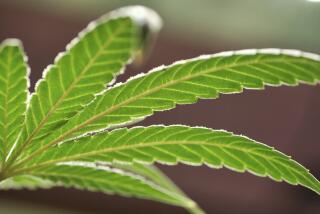Data on marijuana treatment present a distorted picture
- Share via
Re “Marijuana Use Is Pushing Teens Into Treatment,” April 26: Allegations that marijuana smokers compose 60% of drug treatment admissions require further explanation and context. According to the Department of Health and Human Services, fewer than one in five people admitted to drug treatment for marijuana in 2001 did so voluntarily, and more than half -- 57% -- were referred by the criminal justice system. In many cases, these were first-time offenders arrested for marijuana possession and given the option by a judge or drug court of entering drug treatment as an alternative to jail.
As such, the dramatic rise in marijuana “treatment” admissions over the past decade is primarily because of a proportional increase in individuals arrested on marijuana charges and referred to drug treatment in lieu of incarceration. At a time when tens of thousands of hard-drug addicts are being denied access to drug treatment due to a lack of bed space and federal funding, it is disconcerting that America’s drug treatment centers are bursting at the seams by needlessly housing marijuana smokers.
Paul Armentano
Senior Policy Analyst
National Organization for
the Repeal of Marijuana Laws
Foundation
Washington, D.C.
*
Cannabis is not “50 times” stronger than in the 1970s. These estimates are based on faulty statistics derived from samples of cannabis that police confiscated and stored in hot evidence lockers before the THC content was assessed. Heat destroys the THC, leading laboratories in the 1970s to estimate that THC concentrations were around 1%. Cannabis that is 1% THC actually has no effect, so obviously, no one would have smoked it.
Cannabis today is probably two or three times stronger than 25 years ago, but this increased potency does not mean people actually get any higher or develop more dependence. In fact, some research shows that stronger cannabis leads people to smoke less, decreasing the risk of lung problems.
Mitchell S. Earleywine
Associate Professor
Department of Psychology
University of Southern
California
*
The story pointed out correctly that there has been a recent increase in teens seeking treatment for marijuana use, but its agreement with the folklore of the drug treatment community is betrayed by the data.
The Health and Human Services data that the article refers to state in no uncertain terms that the number of court-ordered treatment [program] admissions increased every single year (but one) between 1992 and 2001, and that noncriminal referrals were stable or declined from 1995 on.
By perpetrating the myth of increased addictive liability of high-potency marijuana, health professionals are assisting the government in putting the health and safety of the millions of responsible American marijuana smokers in jeopardy.
Adam Scavone
New York
*
Marijuana’s increasing potency is no surprise. Under alcohol prohibition, the strength of liquors rose rapidly and deaths due to alcohol poisoning went up 400%. If government officials and researchers are truly concerned about the rising harm caused by more potent marijuana, they should support legalization and sell safer, more regulated versions of the drug.
Evan Woods
Student
Occidental College
More to Read
Sign up for Essential California
The most important California stories and recommendations in your inbox every morning.
You may occasionally receive promotional content from the Los Angeles Times.













